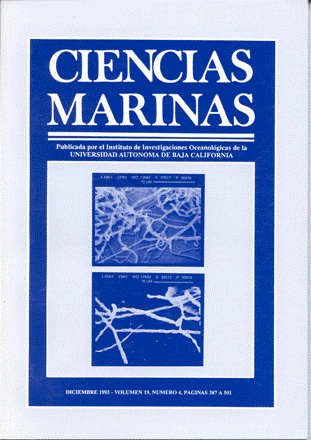Reproductive ecology of Gracilaria pacifica Abbott (Gracilariales; Rhodophyta), in Estero de Punta Banda, Mexico
Main Article Content
Abstract
Two populations of Gracilaria pacifica Abbott, that grow on different types of substrates (mud-sand and rochy) and that differ in the type and dominance of reproductive phases, were studied in Estero de Punta Banda, Baja California (Mexico). To determine whether the lack of hard (rocky) substrate, which allows attachment, and the viability of the tetraspores are related to the absence of cystocarpic plants in beds distributed on a soft substrate (mud-sand), the attachment and viability of the tetraspores, on an artificial substrate (concrete slabs), were evaluated in situ and under semicontrolled culture conditions. The fertility and viability of the tetraspores under controlled laboratory conditions were quantified. The tetraspores from both stations germinated under controlled and semicontrolled conditions. Germination in situ occurred only at the station with hard substrate. In the mud-sand environment, growth of plants on the artificial substrates placed among the beds was not observed. It is concluded that the absence of cycstocarpic plants in G. pacifica beds that grow on a mud-sand substrate cannot be attributed to the lack of hard (rocky) substrate or the viability of the tetraspores.
Downloads
Article Details
This is an open access article distributed under a Creative Commons Attribution 4.0 License, which allows you to share and adapt the work, as long as you give appropriate credit to the original author(s) and the source, provide a link to the Creative Commons license, and indicate if changes were made. Figures, tables and other elements in the article are included in the article’s CC BY 4.0 license, unless otherwise indicated. The journal title is protected by copyrights and not subject to this license. Full license deed can be viewed here.

